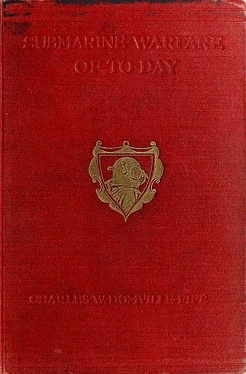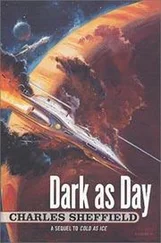The duties on each boat varied and were in the nature of training. The pilot boat was required to lie alongside the cutter, out beyond the harbour, and to convey the pilots at high speed to and from the stream of shipping. It was a pleasant duty which entailed alternate nights in the generous, breezy company of the old sea-dogs of the cutter, with occasional races at half-a-mile a minute through the darkness and spray to the moving leviathans of the ocean.
The patrol ambled up and down the sheltered waterways during the day and night, examining the “permits” of fishermen and preventing the movement of small craft during the hours of darkness, when the long lines of troop-ships were leaving for France.
The work of the duty boats varied from day to day, but there was always the morning and evening mail to be collected from and delivered to the ships of the auxiliary fleet lying out in the fair-way.
When this spell of water-police work was over there came a few days’ practice in the handling of the fast sea-going patrol launches, or “M.L.’s,” about which so much has since been written in the daily papers.
After the cramming received in the lecture-rooms, the arduous drill and the somewhat monotonous work on the slow-moving tenders, the runs seaward on these new and trim little vessels, the manœuvring at nineteen knots, the breeze of passage and the feeling of controlled power acted as an elixir on both mind and body. Then came firing practice in the open sea. The sharp crack of cordite, the tongues of livid flame, the scream of the shells, the white splashes of the ricochet and the salt sea breezes.
Two days later the preliminary training was over and there loomed ahead a period of hard study at the Royal Naval College.
CHAPTER III
A Naval University in Time of War
Built by King Charles I. for the Stuart navy, and used for over two and a half centuries as the university of the Senior Service, the Royal Naval College, Greenwich, is a building with an historic past. It has housed, fed and taught many of England’s most illustrious sailors.
It was to cabin and lecture hall in this fine old building that officers of the new navy went to complete their knowledge of navigation and kindred subjects when their preliminary sea training came to a close.
There is but little romance in a highly specialised course of study designed to enable the recipients to find their way with safety, both in sunshine and storm, over the vast water surface of the world. To describe here the subjects taught would only be wearisome and uninteresting. Sufficient to say that the course was a most comprehensive one and admirably arranged by masters of the mariner’s art. If any fault can be found it is certainly not one of paucity of information, and the proof of its efficacy can be found in the fact that, so far as the author knows, there was not a single ship, afterwards commanded by officers who underwent this training, lost through insufficient knowledge of the art of navigation.
The days spent in the Naval College were fully occupied by attendance at lectures and the evenings in private study and the preparation of elaborate notes and sketches for the final passing-out examination. There was one moment of each day which was rendered historic by old custom. It came at the conclusion of dinner in the big white hall, when the officer whose turn it happened to be rose to his feet and gave the toast of the navy—“Gentlemen, the King!”
It was in the grounds of this college that many officers saw their first zeppelin raid. On one occasion it occurred late in the fourth week of the course. Nearly all were in their respective studies, surrounded by a mass of papers, charts, drawing instruments and books, making the last determined attack on various knotty problems previous to the final examination.
Ten p.m. had just been registered by the electric clocks in the famous observatory overlooking the college, when the sound of running feet came down the long corridors. A stentorian voice shouted: “All lights out!”
In a moment the whole building, with its labyrinth of corridors, was plunged into Ethiopian darkness. Doors were opened and a jostling crowd of men groped their way down passages and stone staircases into the grounds. Here the Admiral and his staff were making sure that no lights were visible. Traffic in the near-by thoroughfare had been stopped, and all around lay the Great Metropolis, oppressively dark and still.
A searchlight flashed heavenwards and was followed by other beams. All of these suddenly concentrated on the gleaming white hull of a zeppelin, high in the indigo sky. The ground trembled under the fire of the anti-aircraft batteries. Shells whistled and moaned over the College and bright flashes came from little puffs of white smoke high in the central blue.
Dull-sounding but earth-shaking booms came from different points as the airship dropped her deadly cargo. Shrapnel fell on the congested house-tops with a peculiar hiss and thud and ambulances rumbled over the stone-paved high-road.
It was a small incident and scarcely worth the space required for its recording, but it served a purpose—to steel the heart and steady the hand for the time to come.
CHAPTER IV
The New Fleets in Being
Back once again on the old cruiser with training completed and awaiting draft to the zones of war. Then came the sailing orders. The name of each officer was called in turn and he disappeared into the ship’s office, to return a few minutes later carrying a sheaf of white and blue Admiralty orders, his face grave or gay according to destination.
Some were for the Spanish Main and bemoaned their fate at being ordered to a station so remote from the principal zone of war. Others were destined for the Mediterranean and comforted themselves with hopes that trouble was brewing elsewhere than in the Adriatic, to which a lucky few were appointed. The Suez Canal and Egypt claimed their share, but by far the greater number were bound for the misty northern seas.
About the training given to the 200,000 men little can be said here because of its diversity. They came as volunteers from all quarters of the globe, were collected at the great depots in Portsmouth, Chatham and Devonport, were trained in the art of signalling, squad drill, gunnery, seamanship and the hundred and one things required by the “handy man,” then belched forth into the ships.
Some had sailed the sea for years before in vessels of all kinds and needed little more than the sense of cohesion and unquestioning obedience imparted by discipline and drill. Others knew more of the working of a loom, or the extraction of coal, than of seamanship, and spent a cheerful but arduous few months in training depots and on special ships completing their education. Cooks there were who could make little else besides Scotch broth, while others, the engineers—or motor mechanics, as they were called when appointed to some of the petrol-driven patrol boats—knew their profession or trade better than they could be taught, and proved themselves untiring and indomitable when it came to the real thing—as will be seen later.
Having now described the training of both officers and men, we come to the ships they were called upon to navigate down to the seas of adventure.
To set on record the formation of the ships of the new navy in divisions, squadrons or units, and to classify them here under separate headings—an easy enough matter with regular fleets constructed for definite duties—is a task of considerable difficulty with a heterogeneous fleet composed of several thousand vessels with seldom two alike.
Beginning with the ocean liners, as the largest and most powerfully armed of the new fleet: these were mostly grouped for administrative purposes in one large formation, known as the “Tenth Cruiser Squadron.” But when at sea they operated in smaller units and frequently as single ship patrols. Their principal zone of activity was the vast stretch of Arctic sea extending from Norway and North Russia to Iceland, the Hebrides and Labrador. Their work was arduous in the extreme, as will easily be realised from the nature of the seas in which they primarily operated.
Читать дальше












